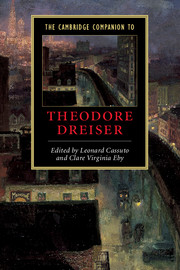4 - Dreiser and the history of American longing
from Part I - Backgrounds and contexts
Published online by Cambridge University Press: 28 May 2006
Summary
Theodore Dreiser had one story to tell, and he never tired of telling it. A young man or woman from the American hinterland flees from provincial boredom or (sometimes) moral disgrace, seeking a new life in the city; the consequences range from exaltation to destruction. Dreiser gave this archetypal form a specific social, historical, and geographical locale. He wrote (repeatedly) the history of the urbanizing United States between the Civil War and World War I, not from any Olympian perspective but from the inside out, from the perspective of clerks and shopgirls striving to do more than merely survive in a baffling new world of threats and opportunities.
Dreiser implicitly recognized the emotional dimension long missing from textbook accounts of “the rise of the city” - the dimension of desire: for sensuous pleasure and luxury, for the intense experience that seemed lacking in everyday life, or at least for some fleeting facsimile of ecstasy. Though in his philosophical asides Dreiser traced human behavior to cosmic forces, his narration of history subverted that sort of determinism. For him, the basic energies of historical change arose from human longings - perverse, unpredictable, and sometimes self-defeating, but powerful, persistent, and never more apparent (he thought) than during the transition to urban modernity.
- Type
- Chapter
- Information
- The Cambridge Companion to Theodore Dreiser , pp. 63 - 80Publisher: Cambridge University PressPrint publication year: 2004



